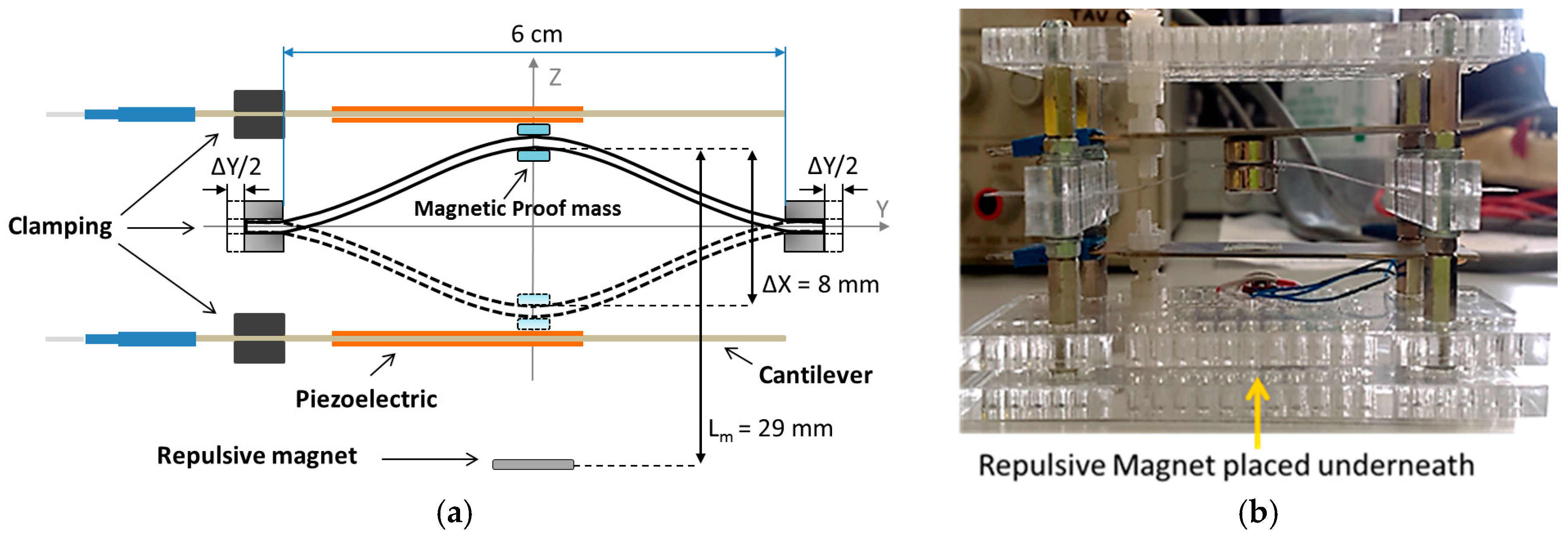A Nonlinear Energy Harvesting with Asymmetry Compensation †
Abstract
:1. Introduction
2. The Nonlinear Energy Harvester: The Experimental Setup
3. Experimental Characterization of the STB Harvester
Author Contributions
Acknowledgments
Conflicts of Interest
References
- Tan, Y.K. Energy Harvesting Autonomous Sensor Systems: Design, Analysis, and Practical Implementation; CRC Press: Boca Raton, FL, USA, 2013; Volume 13, pp. 18–31. ISBN 978-1-4398-9435-4. [Google Scholar]
- Roundy, S.; Wright, P.; Rabaey, J. A study of low level vibrations as a power source for wireless sensor nodes. Comput. Commun. 2003, 26, 1131–1144. [Google Scholar] [CrossRef]
- Baglio, S.; Bulsara, A.R.; Andò, B.; la Malfa, S.; Marletta, V.; Trigona, C.; Longhini, P.; Kho, A.; In, V.; Neff, J.D.; et al. Exploiting Nonlinear Dynamics in Novel Measurement Strategies and Devices: From Theory to Experiments and Applications. IEEE Trans. Instrum. Meas. 2011, 60, 667–695. [Google Scholar] [CrossRef]
- Andò, B.; Baglio, S.; Marletta, V.; Bulsara, A.R. A nonlinear electric field sensor that exploits coupled oscillator dynamics: The charge collection mechanism. IEEE Trans. Instrum. Meas. 2013, 62, 1326–1333. [Google Scholar] [CrossRef]
- Harne, R.L.; Wang, K.W. A review of the recent research on vibration energy harvesting via bistable systems. Smart Mater. Struct. 2013, 22, 023001. [Google Scholar] [CrossRef]
- Andò, B.; Baglio, S.; Bulsara, A.R.; Marletta, V. A bistable buckled beam based approach for vibrational energy harvesting. Sens. Actuators A Phys. 2013, 211, 153–161. [Google Scholar] [CrossRef]
- Andò, B.; Baglio, S.; Bulsara, A.R.; Marletta, V.; Ferrari, V.; Ferrari, M. A Low-Cost Snap-Through Buckling Inkjet Printed Device for Vibrational Energy Harvesting. IEEE Sens. J. 2015, 15, 3209–3220. [Google Scholar] [CrossRef]
- Andò, B.; Baglio, S.; Bulsara, A.R.; Marletta, V.; Pistorio, A. Experimental and Theoretical Investigation of a Nonlinear Vibrational Energy Harvester. Procedia Eng. 2015, 120, 1024–1027. [Google Scholar] [CrossRef]
- Andò, B.; Baglio, S.; Bulsara, A.R.; Marletta, V.; Pistorio, A. Investigation of a Nonlinear Energy Harvester. IEEE Trans. Instrum. Meas. 2017, 66, 1067–1075. [Google Scholar] [CrossRef]
- Andò, B.; Baglio, S.; Bulsara, A.R.; Marletta, V.; Pistorio, A. Performance Investigation of a Nonlinear Energy Harvester with Random Vibrations and Sub-Threshold Deterministic Signals. IEEE Trans. Instrum. Meas. 2017, 66, 992–1001. [Google Scholar] [CrossRef]
- Data Sheet Article S-10-04-N. Available online: supermagnete.it/eng/data_sheet_S-10-04-N.pdf (accessed on 19 June 2017).
- Data Sheet Article Q-10-10-01-N. Available online: supermagnete.it/eng/data_sheet_Q-10-10-01-N.pdf (accessed on 19 June 2017).



| Frequency (Hz) | AccRMS (m/s2) | Power (µW) | Efficiency |
|---|---|---|---|
| 1 | 4.81 | 20.2 | 4.3 |
| 2 | 6.88 | 38.9 | 5.5 |
| 5 | 10.8 | 120 | 7.7 |
Publisher’s Note: MDPI stays neutral with regard to jurisdictional claims in published maps and institutional affiliations. |
© 2017 by the authors. Licensee MDPI, Basel, Switzerland. This article is an open access article distributed under the terms and conditions of the Creative Commons Attribution (CC BY) license (https://creativecommons.org/licenses/by/4.0/).
Share and Cite
Andò, B.; Baglio, S.; Marletta, V.; Pistorio, A.; Bulsara, A.R. A Nonlinear Energy Harvesting with Asymmetry Compensation. Proceedings 2017, 1, 581. https://doi.org/10.3390/proceedings1040581
Andò B, Baglio S, Marletta V, Pistorio A, Bulsara AR. A Nonlinear Energy Harvesting with Asymmetry Compensation. Proceedings. 2017; 1(4):581. https://doi.org/10.3390/proceedings1040581
Chicago/Turabian StyleAndò, Bruno, Salvatore Baglio, Vincenzo Marletta, Antonio Pistorio, and Adi R. Bulsara. 2017. "A Nonlinear Energy Harvesting with Asymmetry Compensation" Proceedings 1, no. 4: 581. https://doi.org/10.3390/proceedings1040581
APA StyleAndò, B., Baglio, S., Marletta, V., Pistorio, A., & Bulsara, A. R. (2017). A Nonlinear Energy Harvesting with Asymmetry Compensation. Proceedings, 1(4), 581. https://doi.org/10.3390/proceedings1040581






